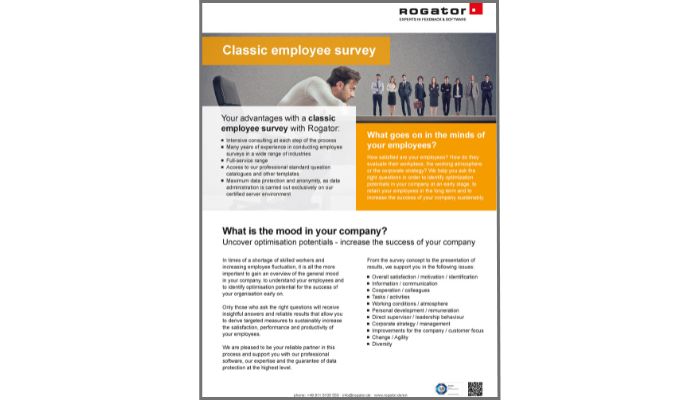
Factsheet Classic employee survey
Employee feedbacks can help your company in its further development. All facts about exit survey can be found here.
The active termination of an employee or, more generally, the departure of a colleague from the company is rarely welcome. As a rule, in addition to the loss of know-how, a gap is left behind which needs to be filled again quickly. Nevertheless, these processes are a reality and companies should actively use them in order to position themselves better in the future. This is why you should find out the reasons why your employees are leaving by conducting an exit survey and learn from the separation.
As your service provider for employee feedback, we design the appropriate feedback process for you individually for the survey of employees who have left or will leave the company. You can benefit from our experience with regard to thematic implementation and invitation management. The continuously collected data will help you better understand why valuable employees are leaving. You can then use this information for your activities to optimize your employer branding.
Your advantages of an exit survey with Rogator
-
Full-service offer
Together with you, we look at the specific conditions in your company and determine the best time to start with exit feedback. The list of questions will be tailored to your company's situation and your previous experience with terminations.
-
Flexible invitation management
We use all reasonable channels to transmit the necessary information: Regardless of whether it is an e-mail, letter invitation or paper survey, the medium is not important. All of this is of course carried out in compliance with the relevant data protection requirements.
-
Precise analyses
Depending on the frequency of personnel changes, various evaluation formats are available: From periodic quarterly reports to automated dashboards, we meet your expectations and ensure that you always have an overview of all developments.
Three important elements of exit feedback
In order to understand the overall process of an exit survey, it is important to understand that, as a rule, these are not singular survey projects that are completed after a certain period of time and end with the final presentation of results. Exit surveys are intended as an ongoing process in which companies learn continuously. The following insights are generally of primary interest:
-
Determine causes
In order to better understand how terminations occur, you should determine the relevant motives. If these motives are predominantly reasons that can be controlled by the respective company, these can be action-relevant fields for concrete improvements. Personal reasons, on the other hand, can hardly be influenced.
-
Feedback of strengths and weaknesses
A person leaving the company often looks at the organisation with a more neutral distance. There is something to be learned from this knowledge about the strengths and weaknesses of the former employer. It is important at this point to use suitable items and fine-grained scales in order to be able to reproduce even nuances and slight fluctuations in response behaviour over time.
-
Insight into the competition
To a certain extent, it is often possible to find out what aspects a former employee values in his future employer - if this has already been determined - or what hopes the colleague places in the new position. Questions of this kind must of course be asked in a very general and neutral manner, so that the impression is not created that the internal affairs of the new company are being asked.
Rogator advises you individually on all questions regarding the exit survey
-
When should the exit survey be carried out?
This should be effected at some time after the end of the employment relationship to ensure a clearer view of the working relationship - free of emotions. It would be important that the leaving employee has already received his or her job reference at this time so that he or she can answer freely and there are no concerns about any possible disadvantages. The willingness to give feedback can be supported if the supervisor personally asks for the feedback in advance.
-
What is the motivation of the participants?
In retrospect and with some time in between, the participant also has the opportunity to neutrally explain the working relationship or the reasons for termination from his or her point of view. Experience has shown that former employees are often grateful and consider it a sign of appreciation to be able to make a written statement again. This may be difficult to articulate in a personal conversation.
-
How many cancellers respond to an exit survey?
These figures vary a lot. They very much depend on the usual reasons for termination. If it is for personal reasons, they are pleased to answer. There is generally somewhat more restraint in the case of negative working conditions or operational backgrounds. In these cases, it may be necessary to choose a medium that is as anonymous as possible or to launch the survey only a few weeks after leaving the company.
-
Which media are suitable for an exit survey?
An online survey with e-mail invitation is generally the most efficient option. In some cases, however, a paper invitation to an online survey (to take home) or a paper-only survey may be the better option. In doing so, the respective circumstances and the assessment of which method promises the highest response rate must be taken into account.
Services at a glance
-
1. Kick-off workshops and consulting
-
2. Questionnaire development and translations, if necessary
-
3. Advice and support for advance communication
-
4. Participant invitation (paper or e-mail)
-
5. Survey implementation (online, paper-pencil, hybrid)
-
6. Evaluation and reporting
-
7. Dashboard
-
8. Follow-up processes

Subscribe to the newsletter now and receive exciting information on the subject of exit surveys
Take the chance and subscribe to our newsletter free of charge. It will provide you regularly with important information about exit surveys, risk assessment and a lot more!




